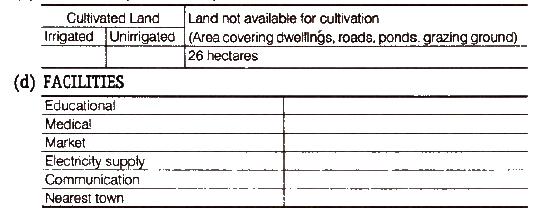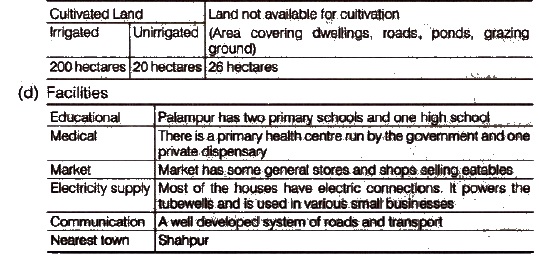NCERT Solutions Class 9th Economics Chp 1 The Story of Village Palampur
Question 1. Every village in India is surveyed once in ten years during the census and some of the details are presented in the following format. Fill up the following based on information on Palampur. (a) LOCATION
(b) TOTAL AREA OF THE VILLAGE
(c) LAND USE(in hectares)

Answer
(a) Location Palampur is located 3 km from Raiganj which is a big village. The nearest town is Shahpur.
- It is well connected with neighbouring villages and towns.
- An all weather road connects the village to Raiganj and further to the nearest small town of Shahpur.
(b) Total Area of the Village
The total area of the Palampur village is 246 hectares.
(c) land Use (in hectares)

Question 2. Modem farming methods require more input which are manufactured in industry. Do you agree ?
Answer Yes, It is true that modern farming methods require more Inputs which are manufactured in industry. For example
- HYV seeds, insecticides, pesticides and chemical fertilisers needed for increasing the yield per hectare are all manufactured industries
- Farmers use farm machinery like tractors, threshers and also combined harvesters which are also manufactured in industries.
- Tubewell equipment and water pumps used for irrigation are also manufactured in industries.
Answer
- Most of the houses in Palampur have electric connections.
- Electricity powers all the tubewells in the fields that help to irrigate much larger areas of land more effectively as compared to the traditional Persian wheel drawn by bullocks. Since the entire cultivated area of 200 hectares had come under irrigation farmers did not have to depend on rainfall and could grow multiple crops.
- It helps small businesses run their machinery like Mishrilal’s sugarcane crushing machine.
Answer Yes, it is important to increase the area under irrigation because water is very essential for agriculture. In India, the rainfall is unevenly distributed in the country and if rainfall Is less, then production Will be low, and they will be only able to grow one crop in a season.
With good irrigation it will be possible to do multiple cropping, helping to increase the yield per hectare
Question 5. Construct a table on the distribution of land among the 450 families of Palampur.
Answer Distribution of land among the 450 families of Palampur.

Question 6. Why are the wages for farm labourers in Palampur less than minimum wages ?
Answer The minimum wages for a farm labourer set by the government are Rs. 60 per day, but wages of farm labourers in Palampur are less than minimum wages because there is heavy competition for work among the farm labourers in Palampur, so people agree to work for lower wages.
Question 7. In your region, talk to two labourers. Choose either farm labourers or labourers working at construction sites. What wages do they get? Are they paid cash or kind? Do they get work regularly? Are they in debt?
Answer
- In our region, there are two labourers namely Ram Khilawan and Basanti, who are husband and Wife working as casual constructing labourers. Due to drought, they had to leave their village in search of employment. They get approximately 50 to 60 rupees per day which they are paid in cash.
- They do not get work regularly because there are a large number of workers seeking employment, due to which they agree to work for low wages. Because of irregular work and low wages they are unable to fulfill their needs and are in debt.
Answer Multiple cropping and use of modern farming methods are two different ways of increasing production on the same piece of land. e.g.,
(i) Multiple Cropping When more than one crop is grown on a piece of land during the year it is known as multiple cropping.
- It is the most common way to increase production on a given piece of land.
- All farmers in Palampur grow atleast two main crops, many are growing potato as the third crop in the past fifteen to twenty years.
- Farmers of Punjab, Haryana and Western Uttar Pradesh were the first to try modern farming methods in India.
- The farmers in these regions set up tube wells for irrigation and made use of HYV seeds, chemical fertilisers and pesticides In farming.
- Some also used farm machinery like tractors and threshers, which made ploughing and harvesting faster. They were rewarded with high yields of wheat, increasing from 1300 kg per hectare to 3200 kg per hectare with HYV seeds.
Answer
- A farmer having 1 hectare of land for farming is called a subsistence farmer because 1 hectare of land is too lese;for even the sustenance of a small family.
- Production Is very low and it is very difficult for the farmer to provide for his family.
- Apart from working on his own field he has to work on the field of the rich farmers or work as a casual labourer to survive.
- The small farmer has no irrigation facilities.
- He has no working capital so he is also not able to buy modern machinery, HYV seeds or insecticides and pesticides.
- In the absence of capital, he has to take loan from moneylender who charges a high interest rate. He is rarely able to repay the loan and eventually falls into a debt trap.
Answer Modern farming methods such as use of HYV insecticides pesticides etc require a great deal of capital so the farmer needs more money than before.
- The medium and large farmers have their own savings from farming. They are thus able to arrange for the capital needed.
- In contrast, the small farmers have to borrow money to arrange for the capital. They borrow from large farmers or the village moneylenders or the traders who supply various inputs for cultivation.
- The rate of interest on such loans is very high. They are put to great distress to repay the loan, which is not so in the case of medium and large farmers.
Answer Savita, a small farmer, in order to cultivate wheat on her 1 hectare of land, decides to borrow money from Tejpal Singh a large farmer on the
following terms
- Tejpal Singh agrees to give Savita the loan at an interest rate of 24 per cent for four months which is a very high interest rate. Savita also has to promise to work on his field as farm labourer during the harvest season at Rs. 35 per day.
- The rate of interest charged by Tejpal Singh was higher than that of banks. If Savita had taken the loan from the bank, interest would have been lower and she could have easily repaid the loan and her condition would have been far better.
Answer
- On talking to two old residents Ramlal and Dharam Singh I came to know about the irrigation methods that were traditionally in use in our area. They told me that earlier they were dependent on rainfall and later on they started to use the Persian wheel to draw water from the wells. With development of technology, tubewells were used for more better and effective irrigation.
- In the farming methods, traditionally they ploughed the field with ploughs drawn by bullocks which was a very difficult and time consuming process. They used ordinary seeds and cow dung manure for fertilisation.
- However with changes in technology the farmers started using HYV seeds, chemical fertilisers, insecticides, pesticides and modern machinery like tractors and threshers which has led to an increase in yield per hectare and improved the lives of the farmers.
Answer
- Dairy is a common activity in many families of our region.
- Some people are involved in small scale manufacturing in their homes or in the field like production of jaggery by Mishrilal.
- A few people are involved as shopkeepers and traders who buy various goods from the wholesale market in the cities and sell them in the villages.
- Some people near the bus stand have opened shops selling eatables.
- Some people are in the transportation sector ferrying people and carrying goods from one place to another In different types of vehicles.
- People like Kareem opened a computer class centre and also provided employment to two women who had a diploma in computer application.
Answer
- Banks should provide loans at low Interest rates so that the poor villagers can start some business to help them earn a living.
- Government should be more active and start and effective employment generating schemes.
- Government should provide training to the villagers in different small crafts.
- Government should provide facilities for transportation and selling of locally manufactured goods of the villagers in the cities.
- Industries can be set up in rural areas.
 |
| Story of Village Palampur |
Join the conversation